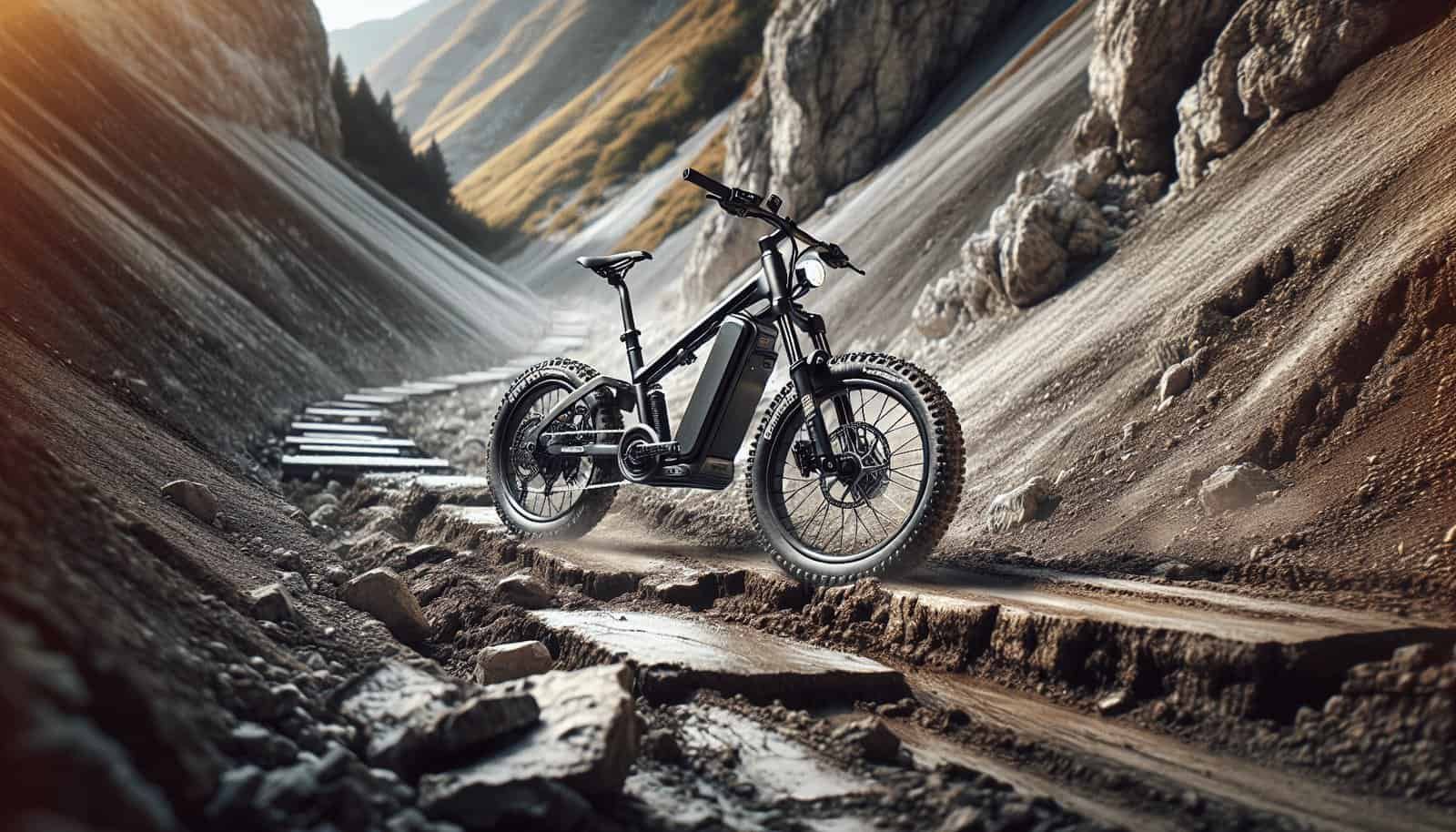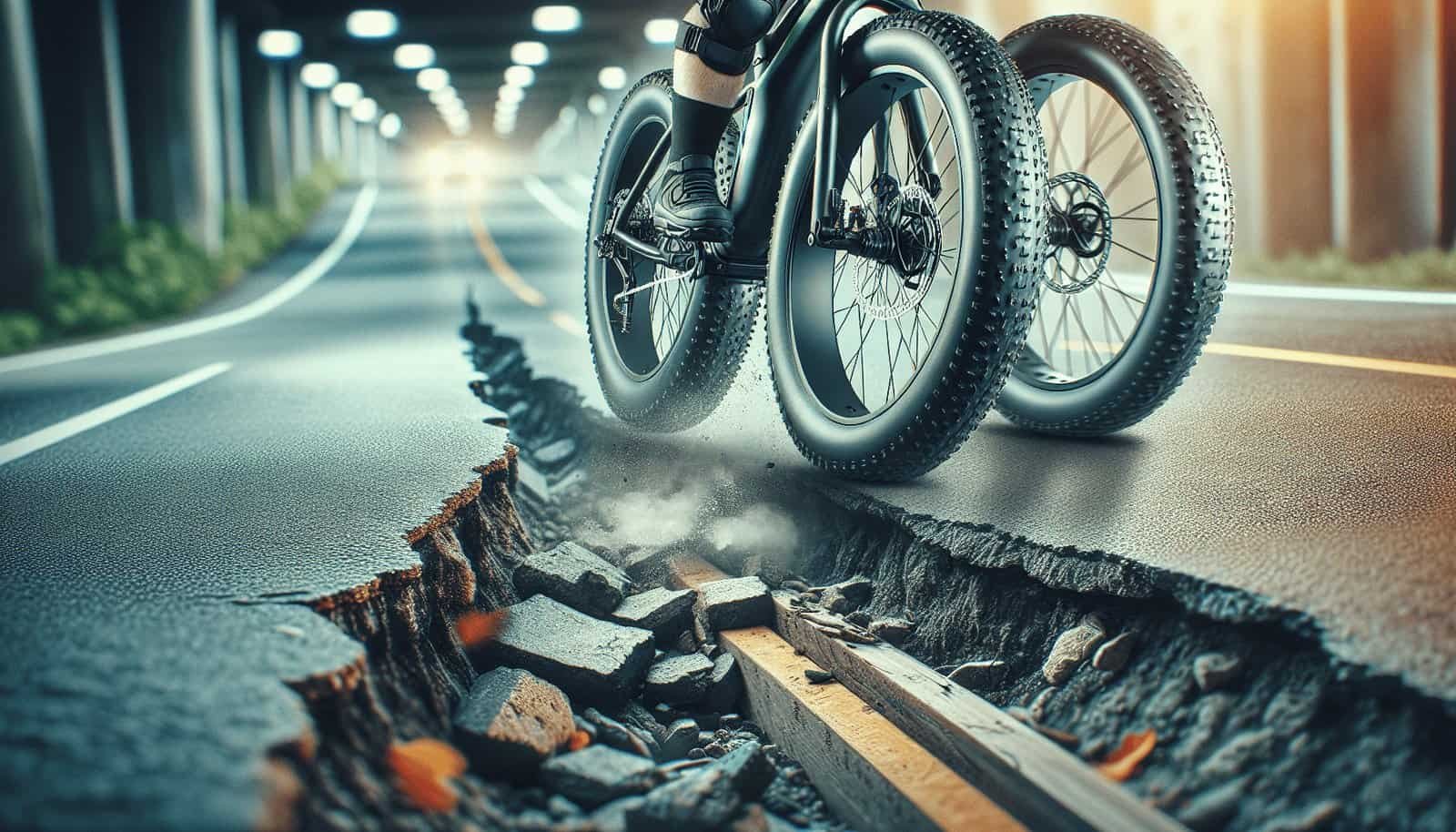Imagine cruising down the street on your electric bike, feeling the cool breeze on your face and the thrill of the ride. But what happens when you encounter a bumpy road or a treacherous pothole? How do electric bikes handle these obstacles? In this article, we’ll explore the durability and suspension systems of electric bikes and uncover the tricks that help them smoothly navigate rough roads and potholes, ensuring a comfortable and enjoyable ride. Strap on your helmet and get ready to discover the secret behind these two-wheeled wonders!

1. Suspension Systems
Electric bikes are equipped with suspension systems to enhance ride comfort and ensure a smoother journey, even on rough roads and potholes. These suspension systems play a vital role in absorbing shocks and vibrations, improving overall stability, and reducing rider fatigue. There are three main types of suspension systems commonly found on electric bikes: front suspension, rear suspension, and full suspension.
1.1 Front Suspension
Front suspension, also known as a fork suspension, is the most common type of suspension system found on electric bikes. It involves the use of a suspension fork located at the front of the bike, which consists of a set of telescopic tubes containing springs and shock absorbers. The front suspension effectively absorbs impacts from bumps and uneven terrain, providing enhanced control and comfort while riding. This is particularly beneficial when encountering potholes or rough roads, as it helps to maintain stability and reduce the jarring effect.
1.2 Rear Suspension
In addition to front suspension, some electric bikes come equipped with rear suspension systems. Rear suspension enhances overall comfort and control by providing additional shock absorption at the rear of the bike. This is especially advantageous when riding over rough terrain, as it helps to mitigate the impact of uneven surfaces and maintain a smoother ride. Rear suspension systems typically use a shock absorber attached to the frame or swingarm, working in conjunction with the front suspension to deliver a balanced and comfortable riding experience.
1.3 Full Suspension
Full suspension, also referred to as dual suspension, combines both front and rear suspension systems to provide the highest level of comfort, control, and shock absorption. Electric bikes with full suspension are particularly suitable for tackling rough roads, uneven trails, and off-road adventures. The combination of front and rear suspension ensures that the bike maintains maximum traction and stability, allowing riders to confidently navigate through challenging terrains. Whether you’re cruising over potholes or conquering rocky trails, full suspension electric bikes offer an unparalleled smoothness and control that enhance your overall riding experience.
2. Tire Types
Electric bikes come with a variety of tire options that cater to different riding styles and conditions. The type of tires you choose can significantly impact how well your electric bike handles rough roads and potholes. Here are three common tire types available for electric bikes:
2.1 Fat Tires
Fat tires are becoming increasingly popular among electric bike riders due to their exceptional stability, traction, and ability to handle rough terrains. These tires are typically wider than standard bike tires, allowing for increased surface contact with the ground. The larger contact area, coupled with lower tire pressure, enables fat tires to absorb shocks and vibrations effectively, making them well-suited for tackling potholes and rough roads. With fat tires, you can confidently explore off-road trails or navigate through urban streets with ease.
2.2 All-Terrain Tires
As the name suggests, all-terrain tires are designed to handle a wide range of surfaces, including both pavement and light off-road trails. These tires strike a balance between grip and rolling resistance, making them versatile for various riding conditions. All-terrain tires often have a moderate width, providing grip on rough roads and ensuring a comfortable ride. While they may not offer the same level of shock absorption as fat tires, all-terrain tires are a popular choice for electric bike riders seeking a more versatile option.
2.3 Hybrid Tires
Hybrid tires are a hybrid between road and mountain bike tires, offering a balance of speed and traction. These tires feature a smoother center tread for increased efficiency on paved surfaces, along with some tread on the shoulders to enhance grip on off-road terrains. Hybrid tires are a good option for electric bike riders who want the best of both worlds: the ability to handle rough roads and potholes while still maintaining decent speed on smoother surfaces. With their versatility, hybrid tires are suitable for both commuting and recreational rides.

3. Frame Design
The frame design of an electric bike plays a crucial role in ensuring stability, comfort, and overall performance, especially when riding over rough roads and potholes. Here are three key aspects of frame design that contribute to a better handling experience:
3.1 Sturdy Construction
A sturdy construction is essential for an electric bike’s frame, as it provides the necessary strength and durability to withstand the rigors of off-road riding and uneven terrains. Electric bikes designed for rough roads and potholes often feature frames made from robust materials such as aluminum or steel. These materials are known for their ability to absorb vibrations and provide stability, ensuring a smooth and controlled ride even in challenging conditions.
3.2 Shock Absorption
To further enhance ride comfort and handling, electric bikes incorporate shock absorption mechanisms into their frame designs. This can be achieved through the use of rear suspension systems, as discussed earlier, or through the integration of shock-absorbing components such as seat posts. Shock absorption helps to minimize the impact of bumps, potholes, and rough terrain on the rider, reducing fatigue and allowing for a more enjoyable riding experience.
3.3 Geometry
Frame geometry plays a significant role in how an electric bike handles rough roads and potholes. The geometry determines the positioning of various components, such as the handlebars, seat, and pedals, as well as the angles and lengths of the frame tubes. A well-designed geometry can contribute to better stability, maneuverability, and control over uneven terrain. Electric bikes with a relaxed geometry, featuring a longer wheelbase and slacker head tube angle, tend to provide more stability, especially on rough roads. On the other hand, bikes with a more aggressive geometry offer increased maneuverability, making them ideal for technical off-road trails.
4. Motor Power and Torque
When it comes to handling rough roads and potholes, the power and torque of an electric bike’s motor are important factors to consider. A powerful motor with adequate torque can make a significant difference in how well your electric bike tackles challenging terrains. Here are three key aspects related to motor power and torque:
4.1 High Power Motors
Opting for an electric bike equipped with a high power motor can greatly enhance your ability to handle rough roads and potholes. A high power motor, typically rated at 500 watts or more, provides ample power to overcome obstacles and maintain a consistent speed even on challenging terrains. With a more powerful motor, you’ll experience improved climbing ability, better acceleration, and the confidence to take on rougher surfaces with ease.
4.2 Torque Sensors
Torque sensors are sophisticated components found in some electric bike motors that measure the amount of force exerted by the rider. These sensors enable the motor to provide assistance proportionate to the rider’s pedaling effort, resulting in a more natural and intuitive riding experience. When encountering rough roads or potholes, torque sensors react instantaneously to changes in pedaling intensity, delivering immediate and smooth assistance to help overcome obstacles and maintain a steady pace.
4.3 Adaptive Motor Assistance
Some electric bikes feature adaptive motor assistance systems that automatically adjust the level of power provided by the motor based on riding conditions. When riding over rough roads or encountering obstacles, these systems detect the increased demand for power and automatically deliver additional assistance for a seamless riding experience. This adaptive motor assistance ensures that you have the necessary power and torque to handle rough terrain, making your rides more enjoyable and effortless.

5. Battery Technology
The battery is an integral component of an electric bike, and its performance directly impacts how well the bike handles rough roads and potholes. Here are three aspects of battery technology that contribute to a better riding experience:
5.1 Large Capacity Batteries
Opting for an electric bike with a large capacity battery ensures that you have sufficient power to tackle rough roads and potholes without worrying about running out of battery. Larger capacity batteries provide increased range, allowing you to comfortably explore off-road trails or venture on longer rides. With a larger capacity battery, you’ll have the peace of mind to enjoy your rides without constantly monitoring your battery level.
5.2 Dual Batteries
Some electric bikes offer the option of dual batteries, allowing for extended range and additional power. Dual battery systems can be particularly advantageous when riding over rough roads and challenging terrains, as they provide extra capacity to handle the increased demands of the motor. With a dual battery setup, you’ll be able to go the extra mile, tackle steeper inclines, and confidently traverse rough terrain.
5.3 Smart Battery Management
Smart battery management systems are designed to optimize the performance and lifespan of the battery. These systems monitor various parameters such as temperature and voltage, ensuring that the battery operates within safe limits. By efficiently managing the battery’s energy output, smart battery management systems not only enhance the overall performance of the electric bike but also contribute to a more consistent power delivery, enabling you to tackle rough roads and potholes with ease.
6. Braking Systems
Proper braking is crucial for maintaining control and safety when encountering rough roads and potholes. Electric bikes come with various braking systems, each offering unique advantages for handling challenging terrains. Here are three common types of braking systems:
6.1 Disc Brakes
Disc brakes are widely regarded as the gold standard in electric bike braking systems. They offer consistent and reliable stopping power, regardless of riding conditions. Disc brakes utilize a metal rotor attached to the wheel hub and calipers with brake pads that grip the rotor to slow down or stop the bike. This design provides excellent stopping power, even in wet or muddy conditions, making it ideal for tackling rough roads and unpredictable terrains.
6.2 Hydraulic Brakes
Hydraulic brakes are known for their smooth and powerful braking performance. These brakes use hydraulic fluid to transfer force from the brake lever to the calipers, resulting in a more efficient and responsive braking experience. Hydraulic brakes offer excellent modulation, allowing precise control over braking power. When riding on rough roads and encountering potholes, hydraulic brakes enable quick and precise braking, providing the confidence and control needed to navigate challenging terrains.
6.3 Regenerative Braking
Regenerative braking is a unique feature found in some electric bikes that allows the motor to assist in braking and recover energy during the braking process. When you engage the brakes, the motor switches into a braking mode, generating resistance that slows down the bike while simultaneously charging the battery. This form of braking can be particularly useful when navigating downhills or encountering steep descents. Regenerative braking not only enhances control and stability but also contributes to extending the electric bike’s range by harnessing energy that would otherwise be wasted during braking.

7. Riding Techniques
Having the right riding techniques is essential for effectively handling rough roads and potholes on an electric bike. Here are three key considerations to keep in mind:
7.1 Flexibility and Agility
Maintaining flexibility and agility allows you to better absorb shocks and adapt to the ever-changing terrain. It’s important to stay loose and relaxed on the bike, using your arms and legs as shock absorbers to cushion the impact of rough roads and potholes. Bending your elbows and knees slightly and adjusting your body position accordingly can significantly improve your ability to tackle rough terrain and maintain balance.
7.2 Speed Regulation
Controlling your speed is crucial for handling rough roads and potholes safely. When approaching rough terrain, slowing down allows you to better navigate obstacles and gives you more time to react to unexpected bumps or potholes. Gradually decrease your speed before encountering rough sections, and maintain a steady, controlled pace to minimize the impact of bumps and maintain stability.
7.3 Avoiding Obstacles
One of the most effective ways to handle rough roads and potholes is to anticipate and avoid obstacles whenever possible. Keep a vigilant eye on the road ahead, looking out for potential hazards such as potholes, loose gravel, or debris. When you spot an obstacle, try to steer around it, taking a different path if necessary. By actively avoiding obstacles, you can minimize the impact on your bike and enhance your overall riding experience.
8. Additional Accessories
Several additional accessories can further enhance your electric bike’s handling capabilities and overall riding experience. Here are three popular accessories to consider:
8.1 Suspension Seat Post
A suspension seat post can greatly enhance ride comfort and shock absorption, particularly when encountering rough roads and potholes. This accessory replaces your standard seat post and incorporates a suspension mechanism that effectively absorbs shocks and vibrations, reducing strain on your lower back and improving overall comfort.
8.2 Handlebar Grips
Handlebar grips play a crucial role in maintaining control and reducing hand fatigue. Opting for ergonomic grips with cushioning and vibration-damping properties can significantly improve your ability to handle rough roads and potholes. These grips provide a comfortable and secure hold, minimizing the jarring effect of uneven terrain and increasing overall control.
8.3 Frame Bags
Frame bags offer convenient storage options for carrying essential items such as tools, spare parts, or personal belongings. By distributing the weight evenly across your electric bike’s frame, frame bags help to maintain balance and stability, contributing to better handling and control in rough road conditions.
9. Maintenance and Care
Regular maintenance and care are crucial for ensuring that your electric bike continues to handle rough roads and potholes smoothly. Here are three maintenance tasks to prioritize:
9.1 Regular Cleaning
Cleaning your electric bike regularly is essential for maintaining its performance and durability. Removing dirt, mud, and debris from your bike’s components, particularly the suspension systems, will help ensure smooth operation and prevent premature wear. Regular cleaning also gives you an opportunity to inspect your bike for any signs of damage or wear that may affect its handling.
9.2 Tire Pressure Check
Maintaining the correct tire pressure is vital for optimal handling and ride comfort. Check your electric bike’s tire pressure regularly, as recommended by the manufacturer, and adjust it accordingly. Low tire pressure can significantly impact your bike’s ability to handle rough roads and potholes, while overinflated tires can result in a harsh and uncomfortable ride.
9.3 Suspension Maintenance
Proper maintenance of your electric bike’s suspension systems is crucial for ensuring optimal performance and longevity. Follow the manufacturer’s recommendations for suspension maintenance, which may include regular inspection, lubrication, and adjustment of the suspension components. By keeping the suspension in good condition, you’ll enjoy a smoother ride, enhanced handling, and improved control over rough terrain.
10. Choosing the Right Electric Bike
When it comes to handling rough roads and potholes, choosing the right electric bike is essential. Here are three key considerations to help you make an informed decision:
10.1 Research and Test Rides
Before making a purchase, conduct thorough research on different electric bike models and their respective features. Look for bikes specifically designed to handle rough roads and potholes, and read customer reviews to gain insights into their performance in such conditions. Whenever possible, take the opportunity to test ride the electric bike you’re considering to get a firsthand experience of how well it handles rough terrains.
10.2 Consider Riding Conditions
Consider the specific riding conditions you’ll encounter regularly. If you frequently ride on rough roads or uneven terrains, prioritize electric bikes with durable frames, robust suspension systems, and suitable tire types. Understanding your typical riding conditions will ensure that the electric bike you choose is well-suited to handle the challenges you’ll face.
10.3 Consult with Experts
When in doubt, seek advice from electric bike experts or professionals at reputable bike shops. They can provide valuable insights and guidance based on their knowledge and experience. By consulting with experts, you’ll gain a better understanding of the features and specifications that contribute to an electric bike’s ability to handle rough roads and potholes effectively. They can also help you find the right electric bike that meets your specific needs and preferences.
In conclusion, electric bikes can handle rough roads and potholes effectively by utilizing various features and technologies. Suspension systems, tire types, frame designs, motor power and torque, battery technology, braking systems, riding techniques, additional accessories, maintenance, and choosing the right electric bike all play important roles in ensuring a smooth and enjoyable riding experience, even in challenging terrain. By considering these factors and selecting an electric bike that meets your specific needs, you’ll be well-equipped to confidently tackle rough roads and potholes while enjoying the many benefits of electric biking.

